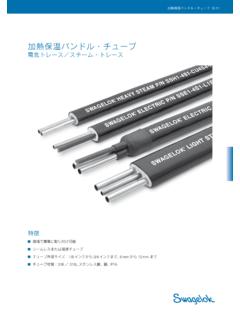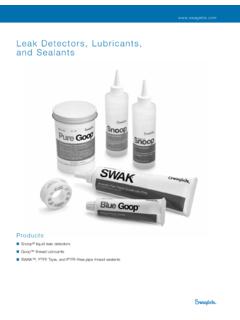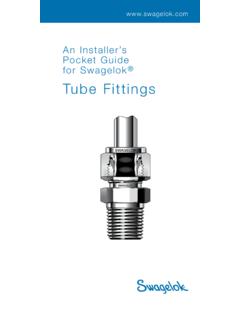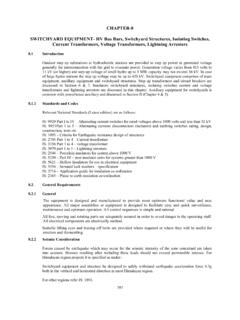Transcription of Bench Top Tube Bender - Swagelok
1 Bench Top Tube BenderUser s Manual Electric and manual units Bends fractional and metric tubing CE compliant2 Bench Top Bender User s ManualContents Safety Instructions .. 2 Technical Data .. 2 Tubing Data .. 3 Bend Layout .. 4 Manual Bender Product Information .. 6 Setup .. 7 Calibration .. 8 Unloading the Bender .. 9 Operation .. 10 Electric Bender Product Information .. 11 Setup .. 12 Calibration .. 14 Unloading the Bender .. 14 Operation .. 15 Measuring the Bend Angle .. 16 Bend Data Tables Fractional Tubing .. 17 Metric Tubing ..24 Fractional Tubing with Metric Dimensions .. 30 Minimum Length of Last Leg Fractional Tubing ..37 Metric Tubing ..38 Fractional Tubing with Metric Dimensions ..39 Maintenance .. 40 Replacement Parts .. 41 Accessories .. 43 Troubleshooting .. 44 Warranty .. 44 Safety InstructionsREAD THIS MANUAL BEFORE USING THE Bench TOP TUBE Bender .
2 WARNING Statements that identify conditions or practices that could result in death or serious injury . CAUTION Statements that identify conditions or practices that could result in minor or moderate injury or damage to property . CAUTION - EYE PROTECTION Eye protection must be worn while operating or working near equipment . CAUTION - PINCH POINTS Keep hands, loose clothing, and long hair away from moving parts . Injury can occur .Technical DataBending Range1 to 180 . Do not bend tube in excess of 180 .Dimensions (tube Bender in case)Width 21 in . (53 cm)Depth 11 in . (28 cm)Height 14 .5 in . (37 cm)Weight (tube Bender in case, excluding tooling)Manual unit 75 lb (34 kg)Electric unit 79 lb (36 kg)Power Requirements (electric unit)MS-BTB-1 110 V (ac) 50/60 Hz; maximum current: 10 AMS-BTB-2 230 V (ac) 50/60 Hz; maximum current: 5 A Bench Top Bender User s Manual 3 Tubing Data The Swagelok Bench top tube Bender bends 1/4, 3/8, 1/2, 5/8, 9/16, 3/4, 7/8, 1 in.
3 , and 1 1/4 in . and 6, 10, 12, 14, 15, 16, 18, 20, 22, 25, 28, and 30 mm outside diameter tubing in a variety of wall thicknesses . Tubing should be free of scratches and suitable for bending and flaring .Suggested Tubing Ordering InformationHigh-quality, soft-annealed, seamless carbon steel hydraulic tubing ASTM A179 or equivalent . Hardness 72 HRB (130 HV) or less .Fully annealed, high-quality (Type 304, 316, etc .) (seamless or welded and drawn) stainless steel hydraulic tubing ASTM A269 or A213, or equivalent . Hardness 80 HRB (114 HV) or less .Metric TubingSuggested Tubing Ordering InformationHigh-quality, soft-annealed, carbon steel hydraulic tubing DIN-2391 or equivalent . Hardness 130 HV (72 HRB) or less .Fully annealed, high-quality (Type 304, 316, etc .) stainless steel tubing EN ISO 1127 or equivalent . Hardness 180 HV (80 HRB) or less .Fractional TubingTubeODApproxBendRadiusCarbon SteelWall ThicknessMin/MaxStainless SteelWall ThicknessMin/MaxDimensions, in.
4 1/41 . 420 .028/0 .0653/81 . 420 .035/0 .0650 .035/0 .0833/82 . 200 .035/0 .0650 .035/0 .0831/21 . 420 .035/0 .0831/22 . 200 .035/0 .0655/81 . 810 .035/0 .0950 .049/0 .0953/42 . 200 . 049/0 .1097/82 . 640 . 049/0 .10913 .230 .049/0 .1200 .065/0 .1201 1/44 .410 .065/0 .1200 .083/0 .120 TubeODApproxBendRadiusCarbon SteelWall ThicknessMin/MaxStainless SteelWall ThicknessMin/MaxDimensions, mm6360 .8/1 .210361 . 0/1 .512361 . 0/2 .21 .0/2 .014461 . 0/2 .215461 . 0/2 .216461 . 0/2 .51 . 0/2 .218561 . 2/2 .520671 . 2/2 .822671 . 2/2 .825821 . 2/ 3 .01 . 8/3 .0281121 . 8/3 .01 . 8/3 .0301122 .0/3 .0 Nominal TubeODApproxBendRadiusMedium-Pressure TubingIPT Series TubingHeavy-WallAnnealedStainless SteelWall ThicknessMin/MaxCold Drawn1/8 HardStainless SteelWall ThicknessMin/MaxMedium-Pressure Stainless Steel Wall ThicknessHigh-Pressure Stainless Steel Wall ThicknessDimensions, in .1/41 . 420 .065/0 .0950 .028/0.
5 0650 .0710 .0843/81 . 420 . 083/0 .1340 .035/0 .083 3/82 . 200 . 083/0 .1340 .035/0 .0830 .0860 .1251/21 . 420 . 083/0 .1880 . 049/0 .109 9/163 .23 0 .1250 .187 Suggested Tubing Ordering InformationSeamless, austenitic, cold-drawn tubing ASTM A213 or equivalent . Hardness 95 HRB (210 HV) or higher .4 Bench Top Bender User s ManualBend LayoutThis Bender can be used to form single, offset, and other bends . This section contains information for measuring and marking the tube prior to bending . Note: Make all marks 360 around the Bend 1 . Place a reference mark at the end of the tube from which you are beginning the measurements . 2 . Measure from the reference mark and make a measurement mark on the tube at a distance equal to the length of first leg . This mark is the vertex of the bend . 3 . Measure the bend deduction distance for the angle being bent from the measurement mark (see Bend Data Tables beginning on page 17) and make a bend mark on the tube.
6 If the bend deduction is positive, place the bend mark toward the reference mark . If the bend deduction is negative, place the bend mark away from the reference mark . 4 . Refer to the appropriate Operation section to bend the tube .Multiple BendsThe Measure-Bend Method 1 . Follow Single Bend steps 1 through 4 . 2 . Using the vertex of the previous bend as the reference mark, repeat steps 2 through 4 for the next leg . (The vertex is where the center lines of the two legs of the angle intersect .) Example: Using 5/8 in . OD tube and an aluminum bend shoe, make a 90 bend 12 inches from the reference mark followed by a 45 bend with 12 inches between bends . 1 . Place a reference mark at the end of the tube from which you are beginning the measurements .For the first leg: 2 . Measure 12 inches from the reference mark and make a measurement mark to indicate the end of the first leg . 3 . The bend deduction in the Fractional Tubing Bend Data table for a 90 bend using 5/8 in.
7 Tubing and an aluminum bend shoe is 1 3/4 in . 4 . Place the bend mark 1 3/4 in . from the measurement mark going towards the reference mark . 5 . Bend tube 90 according to the appropriate Operation section .For the second leg: 6 . Measure 12 inches from the vertex of the 90 bend and make a second measurement mark, away from the reference mark . 7 . The bend deduction distance in the Fractional Tubing Bend Data table for a 45 bend using 5/8 in . tubing and an aluminum bend shoe is 11/16 in . 8 . Place a second bend mark 11/16 in . from the second measurement mark going towards the first bend . 9 . Bend tube according to the appropriate Operation section .Single Bend BendLength of First LegMeasurement markBend deductionReference markBend markFirst Bend (90 )First 90 lineLength of first leg 12 in .Bend deduction 1 3/4 in .Reference markBend mark5/8 in . OD tubeVertexSecond Bend (45 )Second 90 of second leg 12 in.
8 Bend deduction 11/16 i n .Bend markVertex45 Bench Top Bender User s Manual 5 Reverse BendsThe Measure-Bend MethodSometimes a multiple bend layout will require that a bend be made in reverse . A reverse bend is made with the end of the tube opposite the reference mark inserted into the bend shoe rather than the end with the reference mark . 1 . Measure from the vertex of the preceding bend and place a second measurement mark farther down the tube at a distance equal to the desired length of the leg . 2 . Measuring from that measurement mark, place a bend mark on the tube at the bend allowance for the angle being bent . (See Bend Data tables beginning on page 17 ) . If the bend allowance is positive, place the bend mark away from the preceding bend . If the bend allowance is negative, place the bend mark in the direction towards the preceding bend . 3 . Bend tube according to the appropriate Operation section.
9 Note: When loading the tube into the Bender to make a reverse bend, ensure that the end with the reference mark is not inserted into the bend shoe .Offset CalculationsWhen offset exists, determine the length of offset (L) before calculating for the adjustment from the tube bend . To determine the length of offset, select the offset angle (E) . Then, multiply the offset dimension (O) by the offset bend allowance . Angle Offset Bend Offset (O) Length of Offset (L) (E) Allowance 22 .5 2 . 613 _____ = _____ 30 2 .000 _____ = _____ 45 1 .414 _____ = _____ 60 1 .154 _____ = _____OLE6 Bench Top Bender User s ManualManual BenderProduct InformationBend shoeCarrying handleBend degree wheel (2 1/2 increments)Roller bracket assembly Roller pinsRoller bracket leverRoller knobHand crankHigh bend-speed selectorDrill yoke supportMedium bend-speed selectorLow bend- speed selectorHex drive shaftG pinG rollerRoller bracket assemblyRoller bracket leverRoller knobBracket assembly stopBracket postBracket pinBend shoeSupport bracket Aluminum only, recommended when using 1 in.
10 Or 25 mm bend shoe .Clamp armReference markBracket post stopD pinD rollerZero reference mark Bench Top Bender User s Manual 7 CAUTION When lifting the Bender , first place one hand under the Bender , then pick up the unit by grabbing the carrying handle with your other 1 . Place the hand crank on the high bend-speed selector . 2 . Rotate the hand crank until the zero reference mark on the hex drive shaft is between the 2 and 3 o clock position, when viewed from the operating position .Hex drive shaftZero reference mark3 o clock2 o clock 3 . Rotate the roller knob counterclockwise until it stops .Roller knob 4 . Place the appropriate bend shoe on the hex drive shaft, aligning the zero reference marks on the shoe and the shaft . The bend shoe must be fully bottomed on the hex drive shaft . Zero reference marksBend shoeHex drive shaft 5 . Install the roller bracket assembly on the bracket post . Note: The roller bracket assembly stop must be to the right of the bracket post stop.











